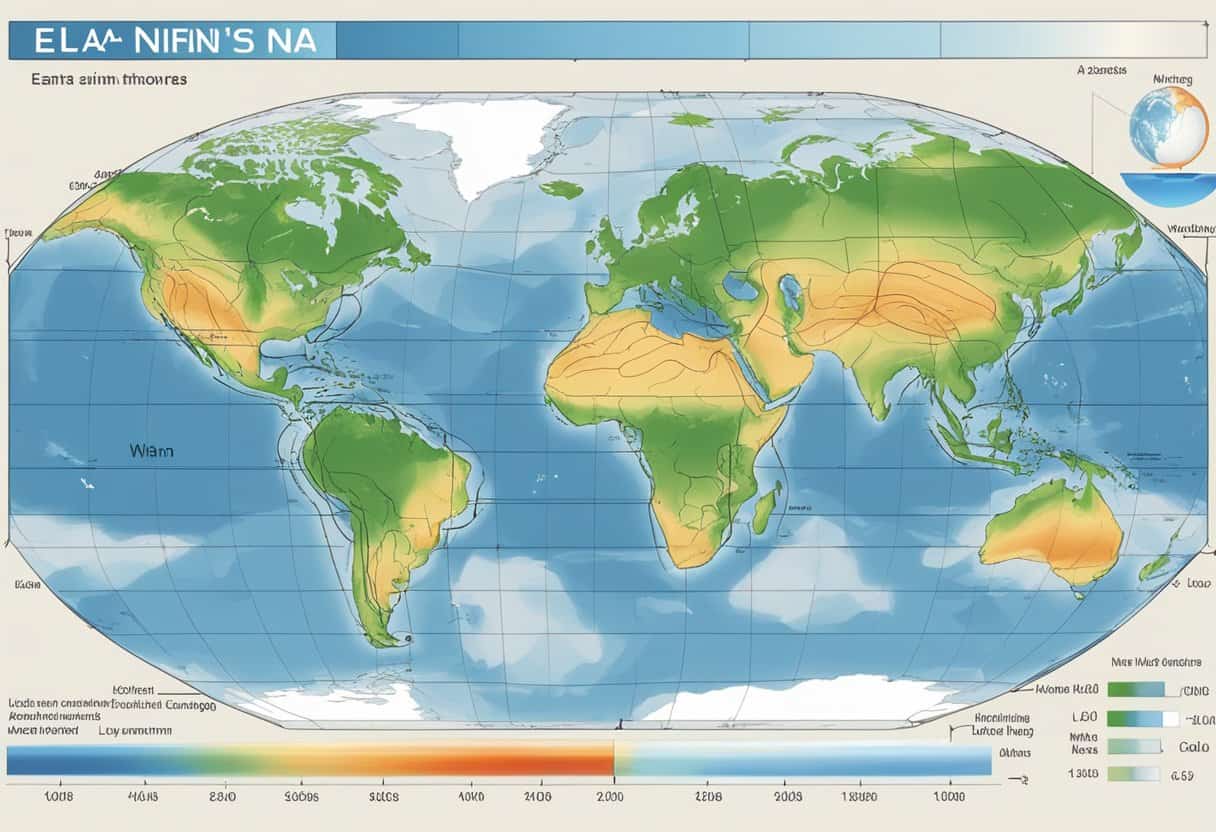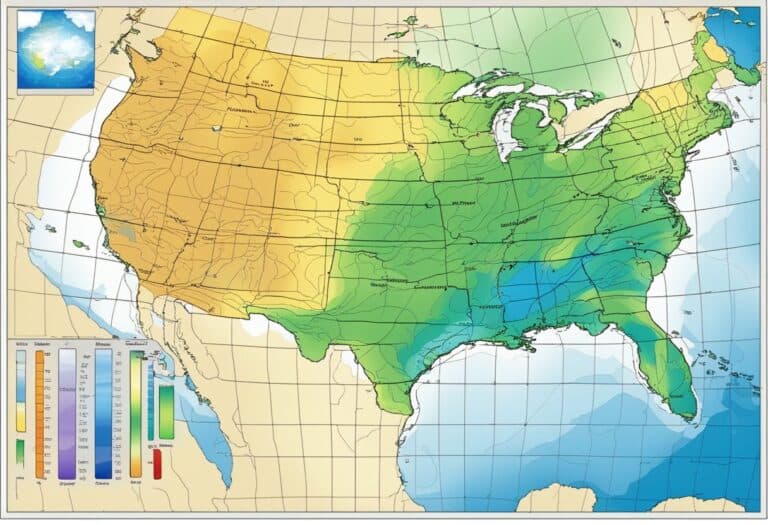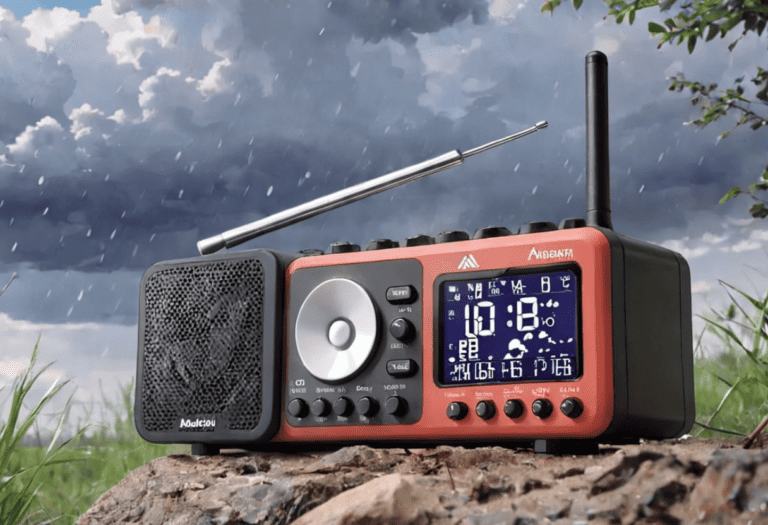El Niño and La Niña are significant climate phenomena that have far-reaching effects on weather patterns across the globe. They are opposite phases of what is known as the El Niño-Southern Oscillation (ENSO) cycle, which represents oscillations in ocean temperatures in the central and eastern equatorial Pacific.
El Niño is marked by the warming of ocean surface temperatures, which can lead to increased rainfall in some parts of the world and drought in others. During La Niña, conversely, the ocean surface temperatures are cooler than average, often resulting in weather patterns that are the opposite of those during El Niño.
Understanding El Niño and La Niña is crucial because they alter the atmosphere’s heat distribution, which in turn disrupts typical weather patterns. The irregularity in climate that these phenomena cause can lead to extreme weather events such as floods, droughts, and changes in storm tracks.
The influence of El Niño and La Niña extends beyond the Pacific Ocean, affecting climate from the coasts of the Americas to Africa, and even influencing monsoon systems in South Asia and Australia. Additionally, the scientific community monitors these conditions closely, using an array of oceanic and atmospheric measurements to predict and prepare for their impacts.
El Niño and La Niña are critical climate phenomena, parts of the ENSO cycle, influencing global weather. El Niño warms Pacific ocean surfaces, altering rainfall and drought patterns, while La Niña cools them, often reversing El Niño’s effects. Their impacts extend globally, affecting agriculture, ecosystems, and weather extremes.
The Basics of El Niño and La Niña
El Niño and La Niña represent significant temperature fluctuations in the Pacific Ocean near the equator that can alter the world’s climate systems. Understanding their definitions and weather impacts helps you grasp their global significance.
Defining El Niño and La Niña
El Niño is characterized by unusually warm sea surface temperatures in the equatorial Pacific Ocean. This warming is part of a complex cycle known as the El Niño-Southern Oscillation (ENSO), which encompasses fluctuations in both the ocean and the atmosphere. During an El Niño event, the trade winds weaken, and warm water that typically lies in the western Pacific moves eastward toward the equator, leading to significant changes in global weather patterns.
La Niña, on the other hand, is identified by cooler-than-average sea surface temperatures in the same region. In contrast to El Niño, during a La Niña, the trade winds are stronger, pushing warmer water towards Asia and the western Pacific and bringing up cooler water from the deep ocean to the east. This too has important repercussions for the atmosphere and global weather.
Differences and Effects on Weather
El Niño and La Niña have inverse effects on weather conditions around the globe.
El Niño often results in:
- Warmer than normal winters in the northern United States and Canada
- Increased rainfall in the southern United States and Peru
- Drought in Western Pacific countries such as Australia and Indonesia
La Niña typically contributes to:
- Cooler, wetter winters in the Pacific Northwest
- Drier, warmer winters in the southern part of the United States
- More active hurricane seasons in the Atlantic due to changes in the atmosphere
Both phenomena can lead to drastic weather patterns across various regions, affecting agriculture, water supply, and disaster management planning. Understanding their effects helps you better prepare for the weather variations these events can cause.
Impacts on Global Climate and Weather Patterns
El Niño and La Niña significantly shape global climate and weather patterns, affecting rainfall, drought conditions, and marine ecosystems. These phenomena can influence weather in various regions, including California, South America, and Asia, leading to profound consequences for agriculture, fishing, and susceptibility to extreme weather events.
Influence on Agriculture and Food Production
Rainfall: During El Niño events, parts of South America experience increased rainfall that can lead to flooding, while regions in Asia and Australia may face drought conditions, adversely impacting your crop yields and food security. Conversely, La Niña typically brings drier conditions to South America and increased precipitation to Southeast Asia and Australia, which can alter planting and harvesting schedules.
Drought: Your farming practices may be seriously disrupted due to El Niño-induced droughts in Asia, leading to water shortages and lower agricultural output. La Niña’s propensity for cooler temperatures and increased rainfall can benefit drought-stricken areas, but it can also cause challenges if the rain is excessive.
Marine Ecosystems and Fisheries
Fishing: El Niño can cause warmer sea surface temperatures that impact the distribution of marine life, leading to declines in fish populations crucial for commercial and subsistence fishing, especially in the Eastern Pacific. During La Niña, the colder nutrient-rich waters can boost fish stocks, benefitting your fisheries and marine biodiversity.
Marine Life: The fluctuating oceanic conditions associated with El Niño and La Niña also influence marine ecosystems, affecting the food chain and habitats of marine species. This fluctuation can have a direct impact on your marine-based food resources and local economies dependent on fishing.
Extreme Weather Events and Disasters
Stormy Weather: El Niño often increases the likelihood of stormier conditions in the southern United States, including California, where you may experience heavy rains and flooding. La Niña contributes to an active hurricane season in the Atlantic and can exacerbate dry conditions in the western U.S., raising the risk of wildfires.
Weather Patterns: Your experience with extreme weather events like storms, hurricanes, and even tornado activity can be influenced by these phenomena. La Niña can bring colder winters to the Northern Hemisphere, while El Niño may cause milder winter temperatures. Both events can disrupt normal weather patterns, making weather-related disaster planning a challenge for you and your community.
Scientific Understanding and Monitoring

You will find that ongoing research and technological advances are imperative for the comprehensive monitoring and forecasting of El Niño and La Niña phenomena, components of the broader El Niño-Southern Oscillation (ENSO) system. Understanding these climate patterns is essential due to their significant impact on global weather, atmospheric circulation, and climate change.
Research and Data Collection
Your understanding of El Niño and La Niña events has deepened through extensive research and continuous data collection. Scientists compile data from various sources, including satellites, ocean buoys, and weather stations to study the complexity of these climate phenomena. Advances in climate models provided by institutions like NOAA have been crucial in interpreting how ENSO events relate to broader climate patterns and atmospheric circulation. The gathered data feed into climate prediction models, enhancing scientists’ ability to understand and anticipate the effects of these events.
Role of Technology and Forecasting
Technology plays a pivotal role in forecasting ENSO events. With the sophisticated climate prediction tools available, you now have access to forecasts that can predict the development of El Niño or La Niña several months in advance. These forecasts hinge on technology such as advanced climate models and global monitoring systems. NOAA and other meteorological agencies utilize these tools to provide you with early warnings and help prepare for potential impacts related to climate change and variabilities caused by ENSO events.
Frequently Asked Questions
El Niño and La Niña significantly affect global weather patterns, ecosystems, and agricultural activities. Here, essential questions about these phenomena are addressed to deepen your understanding.
How do El Niño and La Niña events influence global weather patterns?
El Niño events can lead to extreme weather conditions such as severe droughts in some regions and heavy rainfall in others. On the contrary, La Niña often results in opposite weather patterns, with cooler-than-average sea surface temperatures in the central Pacific causing variations in atmospheric circulation.
What are the primary causes behind the formation of El Niño and La Niña?
These events are primarily caused by fluctuations in ocean temperatures in the equatorial Pacific, combined with changes in the overlying atmospheric circulation. This delicate interaction between the sea surface temperatures and the atmosphere drives the oscillation between El Niño and La Niña conditions.
What distinguishes El Niño from La Niña in terms of climate impact?
El Niño is characterized by warmer-than-average sea surface temperatures in the central and eastern Pacific, leading to a change in wind patterns and reduced upwelling of cold, nutrient-rich water. In contrast, La Niña is marked by cooler-than-average sea surface temperatures in the same region, which can cause increased upwelling and generally has opposing climatic effects to El Niño.
Can El Niño and La Niña be predicted, and what are the effects on seasonal weather forecasts?
These phenomena can be predicted to some extent using climate models and oceanic observations. Predictions contribute to more accurate seasonal weather forecasts, crucial for agriculture, disaster management, and economic planning.
What are some significant consequences of El Niño on marine ecosystems and global agriculture?
El Niño often leads to significant disruptions in marine ecosystems, including coral bleaching and fishery declines due to warmer waters. In terms of agriculture, it can result in reduced crop yields in areas experiencing drought conditions and may also affect food prices and supply chains.
What historical data do we have about the frequency and intensity of El Niño and La Niña cycles?
Records show variability in the frequency and intensity of these events, but typically, El Niño and La Niña occur irregularly, approximately every two to seven years. Historical data indicate shifts in these patterns over time, suggesting a possible influence from climate change.







